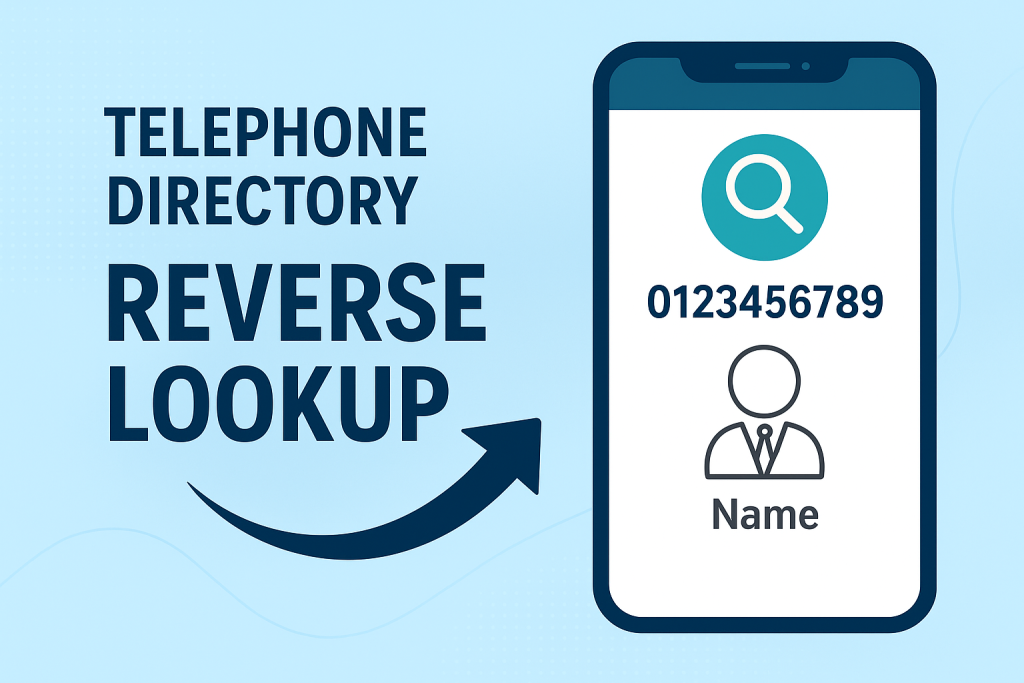Introduction
Have you ever received a call from an unfamiliar number and wondered who it was? Or maybe you’re trying to reconnect with an old friend or verify whether a business number is legitimate. That’s where telephone directory reverse lookup comes in.
In this comprehensive guide, we’ll explore everything about reverse lookup services, including how they work, when to use them, free vs. paid options, and tips to get the most accurate results. Whether you’re in the UK, US, or anywhere else, this article will serve as your ultimate resource.
What Is a Telephone Directory Reverse Lookup?
A reverse lookup allows you to identify the owner of a phone number by entering it into a search tool. Unlike traditional directories (where you search by name to find a number), reverse directories let you search by number to find:
- The name of the caller.
- The associated address (sometimes).
- Whether the number belongs to a landline, mobile, or business.
- Spam or scam reports linked to the number.
These tools are essential in today’s world where unknown calls often bring scams, robocalls, or fraud attempts.
How Does Reverse Lookup Work?
Data Sources
Reverse lookup services rely on a mix of public and private data sources, including:
- Public telephone directories (landlines).
- Business listings and trade registers.
- User-reported databases (like “Who Called Me”).
- Licensed datasets from telecom providers (paid services only).
Limitations
- Mobile numbers: Protected by privacy laws in many countries (e.g., GDPR in the UK).
- Unlisted numbers: Not all numbers are available, especially if the owner opted out.
- Accuracy: Free tools rely heavily on user submissions, which may not always be reliable.
Types of Reverse Lookup Services
1. Free Reverse Lookup Tools
These are widely available online and ideal for quick checks. Examples:
- Who Called Me UK
- Should I Answer
- TrueCaller (limited free version)
Pros: Free, easy to use.
Cons: Limited data, may not work for mobiles.
2. Paid Reverse Lookup Services
These offer access to more detailed records, including mobile numbers and addresses (within legal limits). Examples:
- Whitepages Premium
- BeenVerified
- Spokeo
Pros: More accurate and comprehensive.
Cons: Subscription costs, potential privacy concerns.
3. App-Based Reverse Lookup
Smartphone apps like TrueCaller, Hiya, and Whoscall integrate with your call logs to instantly identify unknown numbers.
Benefits of Using Reverse Lookup
- Identify Unknown Callers – Stop guessing and know who’s calling.
- Avoid Scams & Fraud – Many lookup services flag numbers reported for spam.
- Reconnect With People – Find long-lost contacts when you only have their old number.
- Verify Businesses – Ensure a business is legitimate before sharing personal details.
- Peace of Mind – Reduce anxiety from constant unknown calls.
Reverse Lookup in the UK vs. US
UK
- Landline numbers are easier to trace through BT Phone Book or online directories.
- Mobile numbers are generally not public unless voluntarily listed.
- Community-driven sites like Who Called Me UK are popular for spotting scams.
US
- Wider availability of public records.
- Mobile numbers sometimes included in paid databases.
- Whitepages is the most recognized reverse lookup provider.
Step-by-Step: How to Do a Reverse Lookup for Free
- Copy the number you want to check.
- Paste it into Google Search with quotation marks (e.g., “0123456789”).
- Try free community sites like Who Called Me or Should I Answer.
- Check business directories if you suspect it’s a company.
- If necessary, move to a trusted paid service.
Common Uses of Telephone Directory Reverse Lookup
- Spotting scam calls pretending to be from HMRC, banks, or delivery companies.
- Checking local numbers to see if they belong to businesses or neighbors.
- Verifying missed calls before calling back.
- Tracing old contacts (friends, relatives, or colleagues).
Privacy & Legal Concerns
It’s important to use reverse lookup ethically:
- Don’t use it for harassment or stalking.
- Respect data protection laws (GDPR in Europe, CCPA in California).
- Be cautious with services that promise too much (like “all mobile numbers free”) — these are often scams.
Future of Reverse Lookup Services
With AI and big data integration, reverse lookup tools will become:
- Smarter at identifying spam before the call reaches you.
- Better at integrating with smartphones and messaging apps.
- More protective of user privacy, balancing security with data access.
As mobile numbers become the dominant form of communication, expect reverse lookup services to focus on spam prevention rather than full identity disclosure.
Conclusion
A telephone directory reverse lookup is one of the most useful tools for dealing with unknown callers, scams, and reconnecting with old contacts. While free tools work well for landlines and community reports, paid services are sometimes necessary for more detailed results.
Used responsibly, reverse lookup protects you, saves time, and gives peace of mind in a world full of unknown numbers.
FAQs
1. Can I find mobile numbers with reverse lookup?
Usually no, unless the owner made the number public or you use a paid service with licensed data.
2. What is the best free reverse lookup tool?
In the UK, Who Called Me is popular. In the US, Whitepages (free version) works for landlines.
3. Are reverse lookup services legal?
Yes, as long as they comply with privacy laws like GDPR.
4. Do reverse lookup apps work in real-time?
Yes, apps like TrueCaller and Hiya identify calls instantly using shared databases.
5. Is it safe to use reverse lookup sites?
Yes, but avoid shady sites promising full mobile records for free. Stick to trusted providers.


Leave a Reply